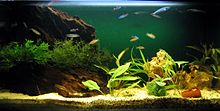Partial water change
A partial water change is the partial replacement of the water in an aquarium with fresh water. In most aquariums, it is one of the regularly performed work and care steps. In contrast to this, backwater aquariums are operated without regular water changes.
Reasons for the partial water change
Most of the living things kept in the aquarium come from habitats in which metabolic waste products are regularly washed away and new nutrients are brought in. In the aquarium this movement of water is partially replaced by filters. However, not all metabolites of fish and invertebrates are completely removed from the water. Certain types of plants also release substances that inhibit other plants from growing, which is known as allelopathy .
The partial water change removes excess nutrients, especially nitrate and phosphate . The main focus here is on trace elements, as the macronutrients nitrate and phosphate get into the tank in more than sufficient quantities through fish feed. It is not relevant for the supply of plants with carbon dioxide. With the exception of freshly set up tanks, at least for less demanding plants, this occurs to a sufficient degree through fish breathing and bacterial degradation processes, as well as through the plants, which themselves use oxygen and release carbon dioxide at night. The plants that are usually adequately supplied by this include the flood arrow herb , the grassy sword plant , waterweed , the Indian water friend , Vallisneria and the Indian water star .
It should be noted, however, that for a significant elimination of pollutants, large water changes are required regularly, as propagated by the Amano school , for example .
frequency
Aquarists have different experiences of how often a partial water change should be made. The recommended change intervals vary between three days and four weeks. Well-planted, large aquariums with a small number of fish are generally more biologically stable and partial water changes are therefore less frequent.
Work steps
The partial water change is usually carried out in connection with the suction of the sludge using a sludge bell. When the water is partially changed, between a quarter and a third of the amount of water is usually removed. It is often refilled with tap water , but also with rain, pond, stream or demineralised water. It is advisable to ensure that the temperature of the water supplied does not differ too much from the aquarium water, as the heating in most aquariums needs a longer time to bring the water back to the desired temperature.
Automatic water change
Nowadays, an automatic computer-controlled water change is possible.
The prerequisite is that there is an automatic overflow, as can be seen in the picture in the center of the picture behind the aquarium. There are commercial aquarium controls, alternatively there is also a timer that, for example, lets in fresh water for 5 minutes every full hour of the day with the help of a valve .
In the picture at the top left there is a control system with various sensors that z. B. measure the temperature, pH value and oxygen saturation and control the water change via switching outputs. The system shown sends an SMS in the event of a power failure or if the values are exceeded . Furthermore, the measured water values are transmitted to a PC (under the aquarium).
Web links
Individual evidence
- ^ Hans-Georg Kramer: Plant aquaristics á la Kramer. Tetra-Verlag, Berlin-Velten 2009, ISBN 978-3-89745-190-2 , p. 74 f.

